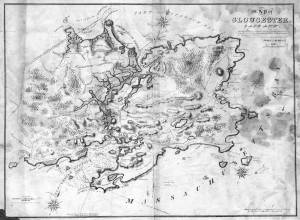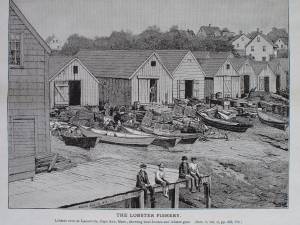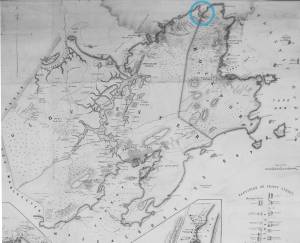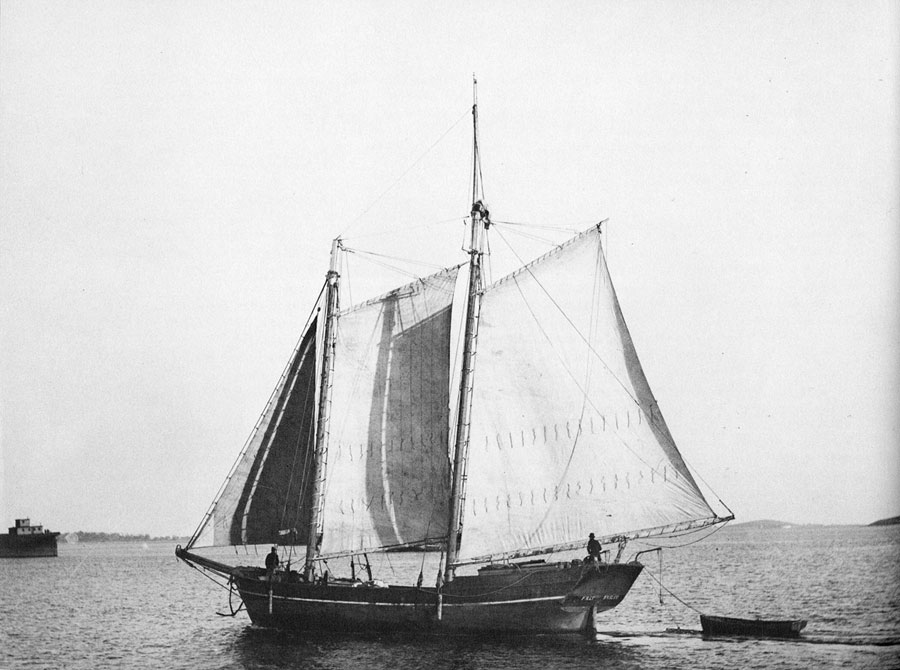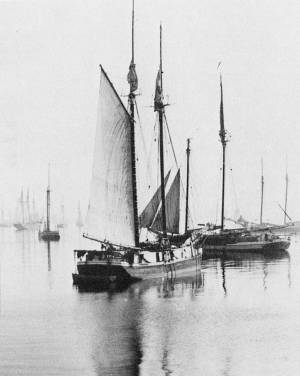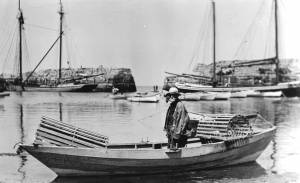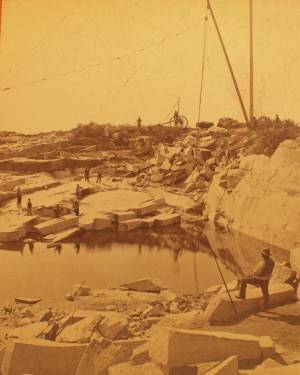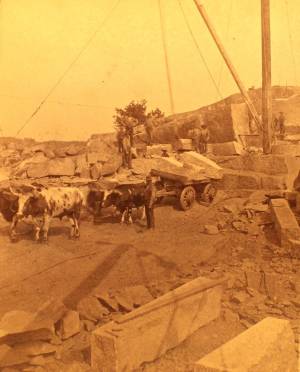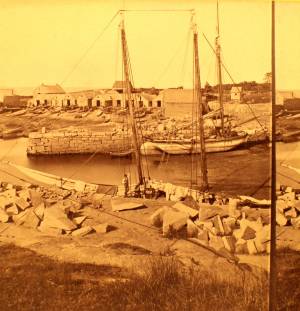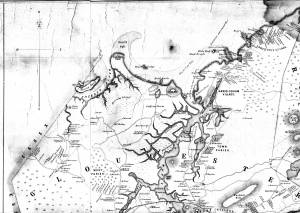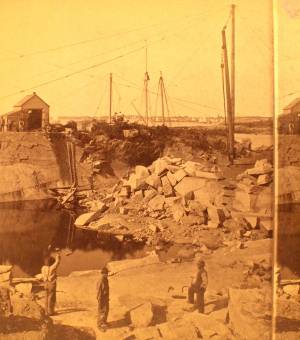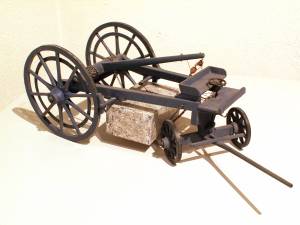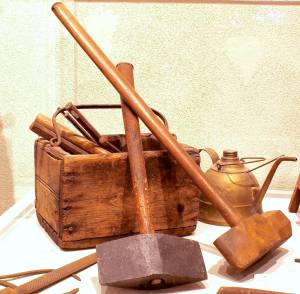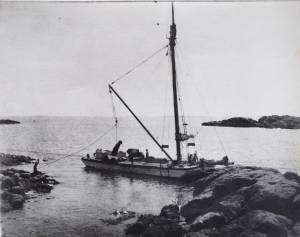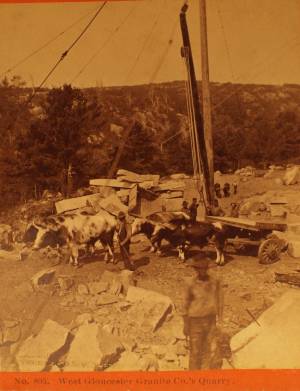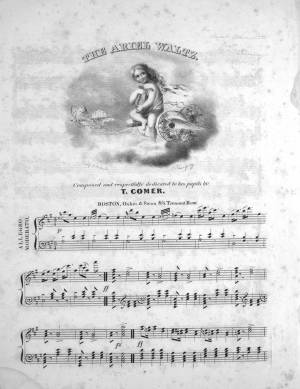An online project under the direction of the CAPE ANN MUSEUM
inv. 157
Folly Cove, Lanesville - Gloucester
1864 Graphite on paper (2 sheets) 9 1/4 x 28 1/4 in. (23.5 x 71.8 cm) Inscribed lower left (in pencil): Lane and Champney took a drive around the Cape. Champney sketched Folly Cove in colors, Lane in pencil. This was his last excursion in that vicinity. He made one painting from the sketch.; Inscribed lower right (in pencil): Folly Cove – Lanesville – Gloucester / F.H. Lane del. July 1864
Inscribed verso (in pencil): S.H.M. [Samuel H. Mansfield] |
Explore catalog entries by keywords view all keywords »
Historical Materials
Below is historical information related to the Lane work above. To see complete information on a subject on the Historical Materials page, click on the subject name (in bold and underlined).
Lane made a sketch of Folly Cove during a drive around Cape Ann with his friend Benjamin Champney. The resulting painting unfortunately has not survived.
Lithograph
28.5 x 21 in.
Cape Ann Museum Library & Archive
When Massachusetts decreed that each town be mapped, John Mason drew the map of Cape Ann in 1830. This drawing was sent to the Senefelder Lithographic Company of Boston (owned by William Pendleton) to be printed, and then sold in Gloucester by W.E.P. Rogers, whose Gloucester Telegraph of February 12, 1831 announced, "A few specimen copies of the map, uncolored, have reached the town" and that they cost $1.25. Perhaps this business arrangement between Pendleton and Rogers provided Lane with his introduction to Pendleton.
Also filed under: Good Harbor Beach / Bass Rocks » // Maps » // Mason, John » // Meetinghouse Green » // Pendleton's, Lith. – Boston » // Salt Island » // Thacher Island »
In G. Brown Goode, The Fisheries and Fishery Industries of the United States (Washington, DC: Government Printing Office)
Cape Ann Museum Library & Archive, Gloucester, Mass.
See pl. 249.
Lobster Cove (Lane's Cove) was a thriving port for the Ipswich Bay shore fisheries from colonial times through the 19th century. Even as late as the mid-20th century, the waterfront was lined with sheds for fishing gear - now all gone. In addition to lobstering, gill-netting, trap fishing, hand-lining, and seining (small-scale) were carried on at various times in pursuit of numerous fish and shellfish types.
– Erik Ronnberg
Also filed under: Lobstering »
Glass plate negative
4 x 5 in.
Cape Ann Museum Library & Archive
#10205/418
Also filed under: Lobstering »
Schooners in Lane’s time were, with few exceptions, two-masted vessels carrying a fore-and-aft rig having one or two jibs, a fore staysail, gaff-rigged fore- and main sails, and often fore- and main topsails. One variant was the topsail schooner, which set a square topsail on the fore topmast. The hulls of both types were basically similar, their rigs having been chosen for sailing close to the wind. This was an advantage in the coastal trade, where entering confined ports required sailing into the wind and frequent tacking. The square topsail proved useful on longer coastwise voyages, the topsail providing a steadier motion in offshore swells, reducing wear and tear on canvas from the slatting of the fore-and-aft sails. (1)
Schooners of the types portrayed by Lane varied in size from 70 to 100 feet on deck. Their weight was never determined, and the term “tonnage” was a figure derived from a formula which assigned an approximation of hull volume for purposes of imposing duties (port taxes) on cargoes and other official levies. (2)
Crews of smaller schooners numbered three or four men. Larger schooners might carry four to six if a lengthy voyage was planned. The relative simplicity of the rig made sail handling much easier than on a square-rigged vessel. Schooner captains often owned shares in their vessels, but most schooners were majority-owned by land-based firms or by individuals who had the time and business connections to manage the tasks of acquiring and distributing the goods to be carried. (3)
Many schooners were informally “classified” by the nature of their work or the cargoes they carried, the terminology coined by their owners, agents, and crews—even sometimes by casual bystanders. In Lane’s lifetime, the following terms were commonly used for the schooner types he portrayed:
Coasting schooners: This is the most general term, applied to any merchant schooner carrying cargo from one coastal port to another along the United States coast (see Bar Island and Mt. Desert Mountains from Somes Settlement, 1850 (inv. 401), right foreground). (4)
Packet schooners: Like packet sloops, these vessels carried passengers and various higher-value goods to and from specific ports on regular schedules. They were generally better-maintained and finished than schooners carrying bulk cargoes (see The Old Fort and Ten Pound Island, Gloucester, 1850s (inv. 30), center; and Gloucester Inner Harbor, 1850 (inv. 240), stern view). (5)
Lumber schooners: Built for the most common specialized trade of Lane’s time, they were fitted with bow ports for loading lumber in their holds (see View of Southwest Harbor, Maine: Entrance to Somes Sound, 1852 (inv. 260)) and carried large deck loads as well (Stage Rocks and the Western Shore of Gloucester Outer Harbor, 1857 (inv. 8), right). Lumber schooners intended for long coastal trips were often rigged with square topsails on their fore masts (see Becalmed Off Halfway Rock, 1860 (inv. 344), left; Maverick House, 1835 (not published); and Lumber Schooner in a Gale, 1863 (inv. 552)). (6)
Schooners in other specialized trades. Some coasting schooners built for carrying varied cargoes would be used for, or converted to, special trades. This was true in the stone trade where stone schooners (like stone sloops) would be adapted for carrying stone from quarries to a coastal destination. A Lane depiction of a stone schooner is yet to be found. Marsh hay was a priority cargo for gundalows operating around salt marshes, and it is likely that some coasting schooners made a specialty of transporting this necessity for horses to urban ports which relied heavily on horses for transportation needs. Lane depicted at least two examples of hay schooners (see Gloucester Harbor, 1850s (inv. 391), left; and Coasting Schooner off Boon Island, c.1850 (inv. 564)), their decks neatly piled high with bales of hay, well secured with rope and tarpaulins.
– Erik Ronnberg
References:
1. Howard I. Chapelle, The History of American Sailing Ships (New York: W.W. Norton & Co., 1935), 258. While three-masted schooners were in use in Lane’s time, none have appeared in his surviving work; and Charles S. Morgan, “New England Coasting Schooners”, The American Neptune 23, no. 1 (DATE): 5–9, from an article which deals mostly with later and larger schooner types.
2. John Lyman, “Register Tonnage and its Measurement”, The American Neptune V, nos. 3–4 (DATE). American tonnage laws in force in Lane’s lifetime are discussed in no. 3, pp. 226–27 and no. 4, p. 322.
3. Ship Registers of the District of Gloucester, Massachusetts, 1789–1875 (Salem, MA: The Essex Institute, 1944). Vessels whose shipping or fishing voyages included visits to foreign ports were required to register with the Federal Customs agent at their home port. While the vessel’s trade or work was unrecorded, their owners and master were listed, in addition to registry dimensions and place where built. Records kept by the National Archives can be consulted for information on specific voyages and ports visited.
4. Howard I. Chapelle, The National Watercraft Collection (Washington, DC: Smithsonian Institution, 1960), 40, 42–43.
5. Ibid., 42–43, 73.
6. Ibid., 74–76.
A topsail schooner has no tops at her foremast, and is fore-and-aft rigged at her mainmast. She differs from an hermaphrodite brig in that she is not properly square-rigged at her foremast, having no top, and carrying a fore-and-aft foresail instead of a square foresail and a spencer.
Wood rails, metal rollers, chain; wood cradle. Scale: ½" = 1' (1:24)
Original diorama components made, 1892; replacements made, 1993.
Cape Ann Museum, from Gloucester Chamber of Commerce, 1925 (2014.071)
A schooner is shown hauled out on a cradle which travels over racks of rollers on a wood and metal track.
Also filed under: Burnham Brothers Marine Railway » // Marine Railways »
Glass plate negative
Collection of Erik Ronnberg
Also filed under: Lobstering »
Details about Maine's lumber trade in 1855, see pp. 250–52
Also filed under: Castine » // Lumber Industry »
The harvesting of granite from quarries dug deep into the earth was an important industry on Cape Ann from the 1830s through the early 20th century. Second only to fishing in economic output, for 100 years the granite business played a pivotal role in the local economy providing jobs for many, turning profits for some and generating tons and tons of cut granite that was used here on Cape Ann and shipped to ports all along the Atlantic seaboard.
Granite quarrying started slowly in this area in the late eighteenth century with small operations peppered across the rocky terrain. Construction of a fort at Castle Island in Boston Harbor in 1798 followed by a jail in nearby Salem in 1813, jump-started the granite industry here on Cape Ann. During the 1830s and 1840s, the trade grew steadily. By the 1850s, the stone business was firmly established and Cape Ann granite was known throughout the region. So extensive and so awe-inspiring were operations during the second half of the nineteenth century some observers feared that the business might actually run out of stone.
While granite was taken from the earth in all different sizes and shapes, Cape Ann specialized in the conversion of that granite into paving blocks which were used to finish roads and streets. Millions of paving stones were shipped out of Cape Ann annually, destined for construction projects in New York, Philadelphia and all along the Atlantic seaboard. While paving blocks were basically uniform in size, there were subtle differences leading some to be referred to as Philadelphia blocks while others were identified as Boston blocks or Washington blocks.
– Martha Oaks (April, 2015)
Stereograph card
Cape Ann Museum Library & Archive
This view shows a wood derrick for hoisting granite blocks.
Also filed under: Eastern Point » // Historic Photographs »
Stereograph
Cape Ann Museum Library & Archive
Also filed under: Historic Photographs »
Stereograph
Cape Ann Museum Library & Archive
Also filed under: Gundalow / Scow »
44 x 34 in.
Henry Francis Walling, Map of the Towns of Gloucester and Rockport, Essex Co. Massachusetts. Philadelphia, A. Kollner, 1851
Cape Ann Museum Library & Archive
"Map of the Towns of Gloucester and Rockport, Massachusetts. H.F. Walling, Civil Engineer. John Hanson, Publisher. 1851. Population of Gloucester in 1850 7,805. Population of Rockport in 1850 3,213."
Also filed under: Annisquam River » // Babson House » // Coffin's Beach » // Eastern Railroad » // Gloucester, Mass. – Annisquam Harbor Lighthouse » // Loaf, The » // Low (David) House » // Maps » // Old First Parish / Subsequent Fourth Parish Church (at the Green) » // Riverdale Methodist Church (Washington Street) » // White-Ellery House »
Stereograph card
Cape Ann Museum Library & Archive
This view shows a wood derrick for hoisting granite blocks.
Also filed under: Eastern Point » // Historic Photographs »
Painted wood
Scale: 1:16. Galamander shop, Vinalhaven, Maine.
Cape Ann Museum. Gift of Barbara Erkkila, 1997
In the nineteenth century granite was hauled from Cape Ann quarries on heavy carts called garymanders which were pulled by oxen or horses (known as "galamander" in Maine.) A boom rigged above the rear axle was used to hoist the stone so it could be held by chains beneath the wagon. The garymander oak wheels were eight feet high with iron rims made by a blacksmith.
Also filed under: Objects »
Cape Ann Museum (1994.65)
Oilcan originally owned by Frederickj "Rick" Larsen
Cape Ann Museum (1994.76.3)
Peen hammer originally owned by Johann Jacob Erkkila (1877–1939)
(Cape Ann Museum) 1994.76.23a
Heavy blacksmith's sledge owned by John Fuge (1873–1967)
Cape Ann Museum (1997.24.0)
Although from a later period, these tools are similar to tools used in Lane's time.
Also filed under: Objects »
Photograph
Private collection
Granite scow being unloaded at Knowlton's Point, Sandy Bay. Sandy Bay Ledge visible in right background, Dodge's Rock in left background.
Also filed under: Gundalow / Scow »
Wood, metal, cordage, cloth, paint.
Scale: ¼ in. = 1ft. (1:48)
Cape Ann Museum. Gift of Roland and Martta Blanchet (1997.17.3)
Although built in 1890 and larger than the stone sloops of Lane’s time, the "Albert Baldwin’s" hull form, rig, and loading boom are very similar to those of the 1840s and 1850s.
Also filed under: Ship Models » // Sloop »
Stereograph
Cape Ann Museum Library & Archive
Also filed under: Historic Photographs »
Benjamin Champney was born in 1807 in New Hampshire. Champney started his career as a lithographer's apprentice in Boston, where he had a studio in the Tremont Temple, as did Lane. They knew each other during their mutual years in Boston, and, as is indicated on one of Lane's drawings, maintained their acquaintance after Lane moved back to Gloucester.
There are records that Champney was in Boston in 1846 and again in 1849; both times he had a studio in the Tremont Temple. Champney placed Lane in the Tremont Temple in the latter year, after Lane’s return to Gloucester. Champney’s mother died in Woburn in the summer of 1849, and “that winter I took a studio in the old Tremont Temple to paint pictures from my summer studies. The rooms on the upper floor were occupied mostly by artists. Among them were ... F. H. Lane of old lithographic days, and now a marine painter.” (1)
After turning to landscape painting, Champney painted the North Conway region of New Hampshire's White Mountains. He is noted for being a forerunner among landscape painters of the White Mountains and was known for his publication, Sixty Years' Memories of Art and Artists, published c.1899. He died in 1907.
Lane and Champney's friendship continued through the years when Lane was in Gloucester. "Champney maintained his friendship with Lane for in July of 1864, the two of them drove to Folly Cove where Lane did a pencil sketch." (2)
(1) Benjamin Champney, Sixty Years' Memories of Art and Artists (Woburn, MA: privately printed, ca.1899), 99, quoted in Sarah Dunlap and Stephanie Buck. "Fitz Who? The Artist Latterly Known as Fitz Hugh Lane." The Essex Genealogist 25, no. 1 (February 2005), 53.
(2) Sarah Dunlap and Stephanie Buck, Fitz Henry Lane: Family and Friends. (Gloucester, MA: Church & Mason Publishing; in association with the Cape Ann Historical Museum, 2007), 185.
Newspaper
p. 2, col. 7
"Extraordinary Exhibition and Sale of a Meritorious Collection of beautiful Oil Paintings and Water Colorings, carefully selected from the studios of the most prominent Artists in Boston and vicinity..." including F.H. Lane
Also filed under: Boston - 1860 New Hall at Bumstead Place » // Bradford, William » // Newspaper / Journal Articles »
Newspaper
p. 3 col. 7
Announcement of Artists' Sale including paintings by F.H. Lane
Also filed under: Boston - 1862 Leonard & Co. Auction » // Curtis, George » // Newspaper / Journal Articles »
Newspaper
"Among the many visitors of the Cape at this delightful season is Champney, the artist, who has been sketching among our quiet coves and breezy headlands."
Also filed under: Newspaper / Journal Articles » // Tourist Industry »
Woburn, MA,
"After a time I left the shoe store, and through the influence of my friend Cooke, was admitted as an apprentice to Moore, successor to Pendleton, in the lithographic business. Here I was speedily worked in as a draughtsman for ordinary commercial work, the fine work, such as designs of figures and heads from life being done by Cooke. F.H. Lane, afterwards well-known as a marine painter, did most of the views, hotels, etc. He was very accurate in his drawing, understood perspective and naval architecture perfectly, as well as the handling of vessels, and was a good, all-round draughtsman." (1)
(1) John Wilmerding. Fitz Henry Lane (Gloucester, MA: Cape Ann Historical Association, 2005). Reprint of Fitz Hugh Lane, by John Wilmerding. New York: Praeger, 1971.
Also filed under: Cooke, Robert » // Pendleton's, Lith. – Boston » // Personal Reviews » // Professional » // Publications »
Also filed under: Sharp & Michelin, Printers – Boston »
Provenance (Information known to date; research ongoing.)
Marks & Labels
Marks: Inscribed upper left (in red ink): 102 [numbering system used by curator A. M. Brooks upon Samuel H. Mansfield's donation of the drawings to the Cape Ann Museum]
